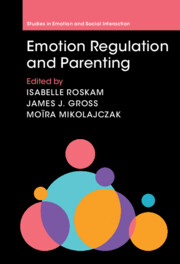Book contents
- Emotion Regulation and Parenting
- Studies in Emotion and Social Interaction
- Emotion Regulation and Parenting
- Copyright page
- Contents
- Figures
- Tables
- Contributors
- Preface
- Part I Conceptual Foundations
- Part II Influence of Parents’ Emotion Regulation on Parenting
- Part III Influence of Parenting on Child Emotion Regulation
- Part IV Current Trends
- Chapter 10 Culture and the Challenges of Being a Good Parent
- Chapter 11 Leveraging Parent–Youth Interactions to Measure and Analyze Emotion Regulation
- Chapter 12 Neurobiology of Parenting and Implications for Emotion Regulation
- Chapter 13 Emotional Labor in Parenting
- Chapter 14 Enhancing Parental Emotion Regulation Skills
- Conclusions and Perspectives
- Index
- Studies in Emotion and Social Interaction
- References
Chapter 14 - Enhancing Parental Emotion Regulation Skills
from Part IV - Current Trends
Published online by Cambridge University Press: 05 January 2024
- Emotion Regulation and Parenting
- Studies in Emotion and Social Interaction
- Emotion Regulation and Parenting
- Copyright page
- Contents
- Figures
- Tables
- Contributors
- Preface
- Part I Conceptual Foundations
- Part II Influence of Parents’ Emotion Regulation on Parenting
- Part III Influence of Parenting on Child Emotion Regulation
- Part IV Current Trends
- Chapter 10 Culture and the Challenges of Being a Good Parent
- Chapter 11 Leveraging Parent–Youth Interactions to Measure and Analyze Emotion Regulation
- Chapter 12 Neurobiology of Parenting and Implications for Emotion Regulation
- Chapter 13 Emotional Labor in Parenting
- Chapter 14 Enhancing Parental Emotion Regulation Skills
- Conclusions and Perspectives
- Index
- Studies in Emotion and Social Interaction
- References
Summary
This chapter examines interventions that focus on parent emotion regulation (ER). Emotions, their function, the different pathways via which emotions are generated, and the role of ER are all briefly introduced to provide the context for the way interventions efforts are considered in the chapter. Interventions that focus on ER in adults drawn from different theoretical perspectives are examined in order to review key common effective components. This is followed by a review of approaches to parent ER used in parenting interventions. We then outline how our own Tuning in to Kids suite of parenting programs targets parent ER. This includes a focus on building parent emotion awareness; promoting insight into parent’s meta-emotion beliefs (how they feel about emotions) and the impact of family of origin experiences on how parents react to emotions; teaching parents proactive, top-down, and bottom-up ER strategies; and how a focus on learning emotion coaching with their children has the added bonus of often enhancing parent ER.
Keywords
- Type
- Chapter
- Information
- Emotion Regulation and Parenting , pp. 264 - 286Publisher: Cambridge University PressPrint publication year: 2023



